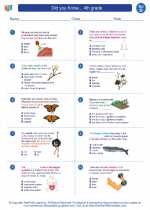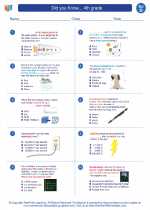Class - Fourth Grade Science
Definition: In science, a class is a group of objects or organisms that have similar characteristics. These shared characteristics can be used to classify and organize the objects or organisms into groups.
Types of Classes:
- Living Things: This class includes all living organisms such as plants, animals, and humans. Living things can further be classified into different groups based on their characteristics, such as vertebrates and invertebrates, or flowering plants and non-flowering plants.
- Non-living Things: This class includes objects and materials that do not possess life, such as rocks, water, and air. Non-living things can be classified based on their properties, such as solid, liquid, or gas.
- Matter: Matter is another class that includes both living and non-living things. Matter can be categorized into solids, liquids, and gases based on their physical properties.
Study Guide:
When studying the concept of class in science, it's important to understand the following key points:
- Identify and classify different objects or organisms based on their shared characteristics.
- Understand the difference between living and non-living things, and how they can be grouped into classes.
- Learn about the properties of matter and how they help in classifying different substances.
- Practice categorizing objects or organisms into various classes based on their observable features.
Remember to use examples and visual aids to help reinforce the concept of class in science.
.◂Science Worksheets and Study Guides Fourth Grade. Did you Know... 4th grade
Study Guide Did you Know... 4th grade
Did you Know... 4th grade  Worksheet/Answer key
Worksheet/Answer key Did you Know... 4th grade
Did you Know... 4th grade  Worksheet/Answer key
Worksheet/Answer key Did you Know... 4th grade
Did you Know... 4th grade  Worksheet/Answer key
Worksheet/Answer key Did you Know... 4th grade
Did you Know... 4th grade 

 Worksheet/Answer key
Worksheet/Answer key
 Worksheet/Answer key
Worksheet/Answer key
 Worksheet/Answer key
Worksheet/Answer key

The resources above cover the following skills:
Core Ideas for Knowing Science
Life Science
Organisms are organized on a cellular basis and have a finite life span.